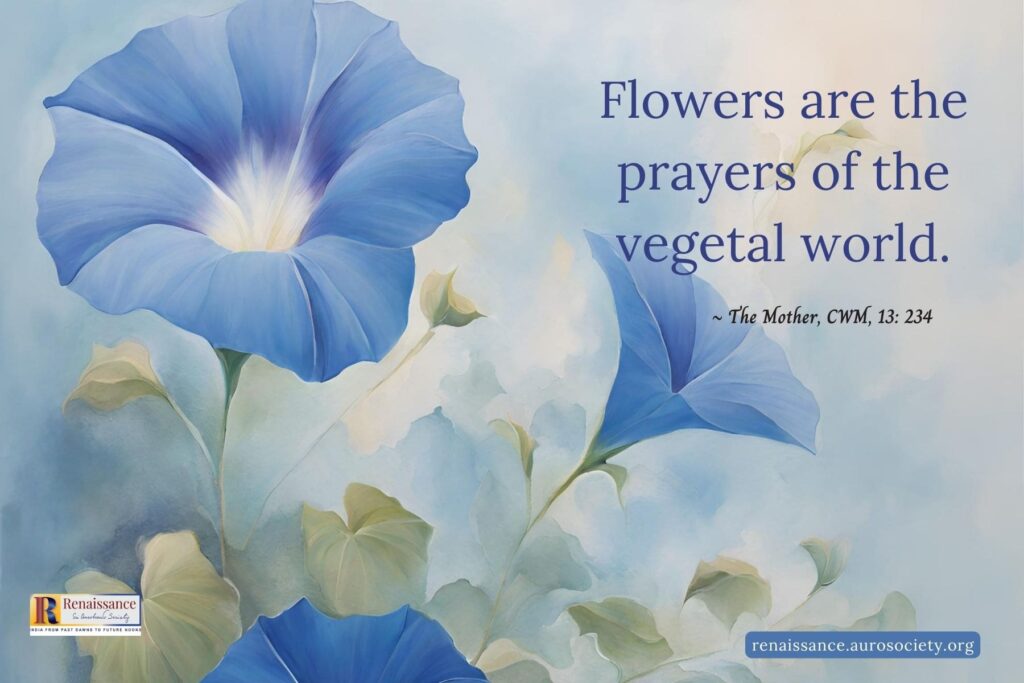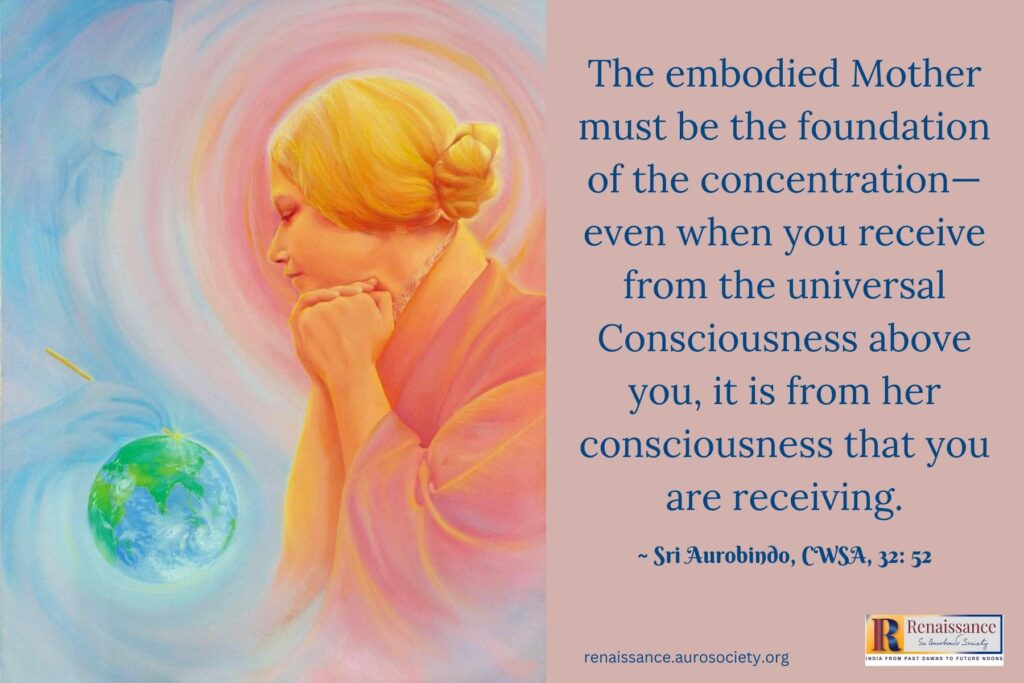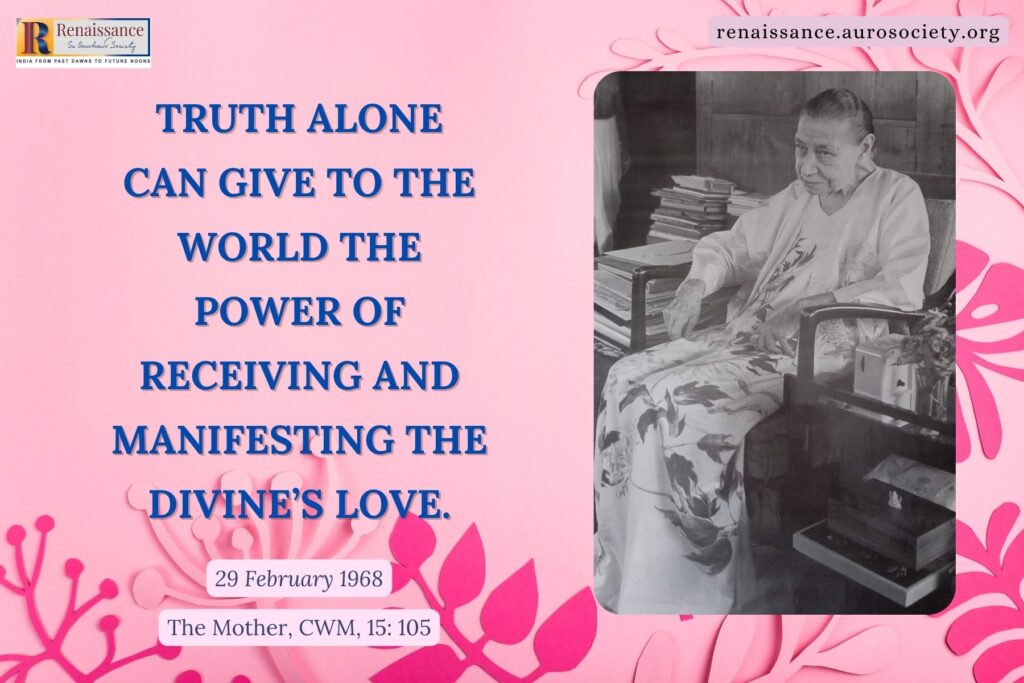Editor’s note: We continue with part 3 of the biography of Major Somnath Sharma, the first recipient of the Param Vir Chakra in independent India. Shyam Kumari, a senior member of Sri Aurobindo Ashram, has written and published this as part of a series of booklets titled ‘Our Heroes: Param Vir Chakra Recipients.’ Her aim is to make the stories of valour and courage reach a large number of Indian youth in schools and colleges.
For the purpose of online presentation, the editors have made a few minor formatting changes.

Continued from PART 2
Lt. Col. Ranjit Rai had now collected his entire battalion. He decided to go up to Baramulla to stop the enemy and moved his unit to just 34 miles from Srinagar. There they came under fire from the enemy’s guns. The enemy far outnumbered the Sikhs and while evacuating his wounded soldiers both he and his deputy were killed. The unit moved back to Srinagar without its officers. These brave officers didn’t sacrifice their lives in vain. If they had not gone to Baramulla, the enemy would have taken Srinagar.
The Army authorities in Delhi were not getting the correct information about the battle situation in Kashmir due to the absence of wireless communication. Therefore, to assess the actual situation, on 29th October brigadier Sen and Brigadier Thapar flew to Srinagar and returned to Delhi the same evening and briefed Pandit Nehru and the Cabinet on the ground situation.
Meanwhile on the 30th and 31st October those courageous pilots kept ferrying the troops and war material on that dusty air strip. The strip by now had become a pile of loose earth and there were clouds of dust.
In Delhi, communal riots were in full swing. In 1946 and 1947, Som’s kumaon battalion had been given the responsibility for maintining peace and internal security in Delhi. His unit discharged its responsibility with a great deal of zeal and impartiality. At that time Som’s left hand was in plaster up to the elbow because of an injury to the wrist bones suffered during a game of hockey. Notwithstanding this, he did not take even one day’s break. Now, his Kumaon battalion was ordered to proceed to Srinagar but Som was told that he could not go because of the plaster.
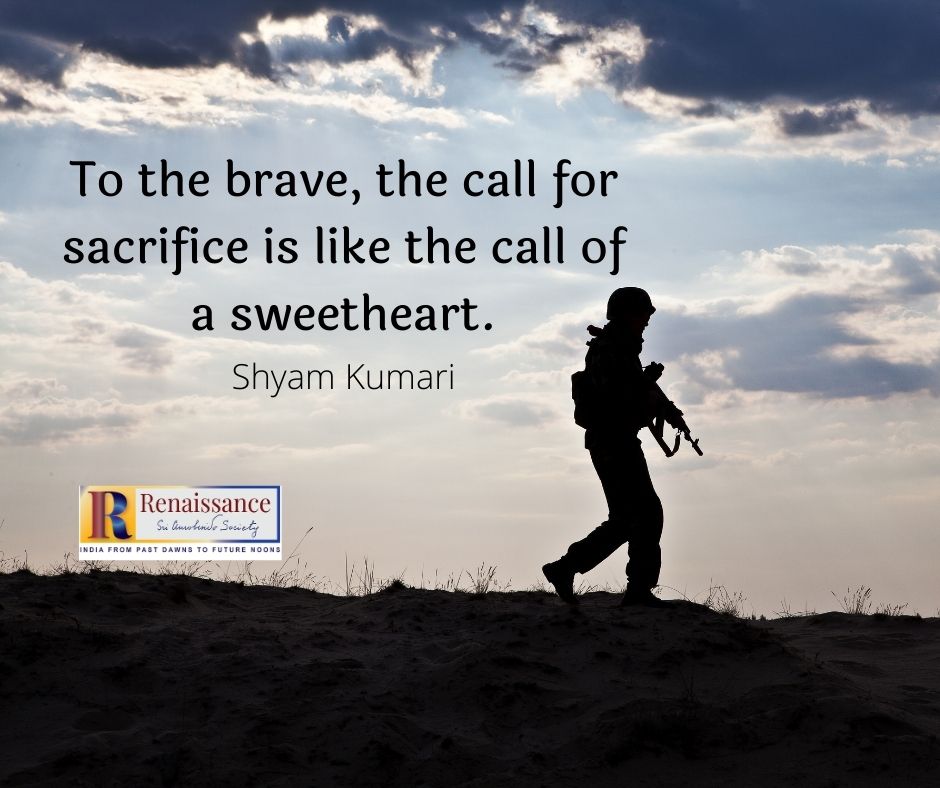
How could Som miss this great opportunity of fighting for and serving his country! During the Burma war, he would often talk with his friends about India’s Independence. Until then he had fought for a foreign government and he was not going to miss the chance to fight for his country.
To the brave, the call for sacrifice is like the call of a sweetheart. Som stated emphatically that no one else could understand his sub-unit better than he and his going with them was essential.
Som had few opportunities to be close to his father, who was posted mostly in far-off lands and places such as Egypt, England, Karachi, Deolali, Landsdowne, to name a few. It was a Divine grace that when Som’s unit was ordered to proceed to Kashmir, his father Maj. General A. N. Sharma was on a visit to Delhi.
Som told him that he had volunteered to go to Kashmir and was flying there the next day. His father told him that he had his arm in plaster for the past few weeks and was therefore not fit for war and should not go to Kashmir. Som replied that for the last five years he had fought for the British and he was not going to miss this opportunity to fight for his country.
In fact, the name recorded in the air manifest to command his sub-unit was of a Sikh officer but Som had the name deleted and added his own.
His argument was that as he was the officer commanding that sub-unit, he had the authority to do what he did. In fact it is surprising that Som was permitted to go to battle because with a handicapped arm an officer can become the cause of danger not only to himself but also to soldiers under him.
It was as if the Goddess of war was asking for the sacrifice of this brave soldier to make a martyr of him.
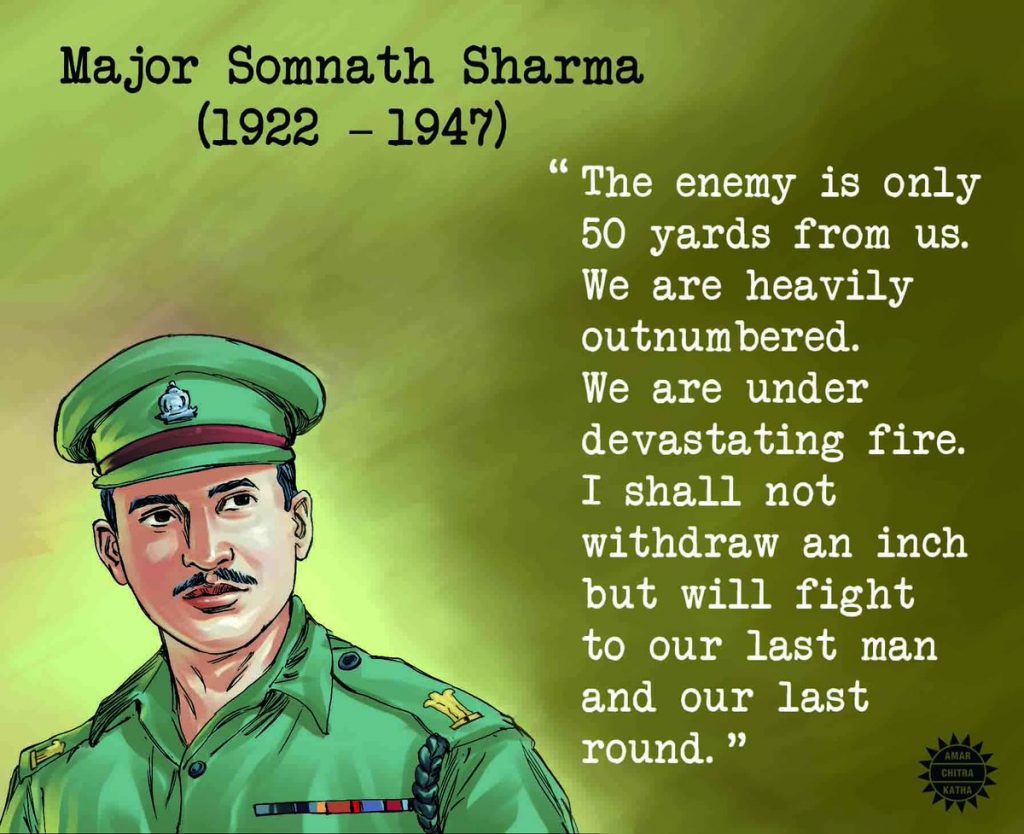
Som met his mother on 31st October before his flight and said, “Mother, are you not proud of me that I am going to fight for my country?” Because of his broken arm, his mother tried to dissuade him. But upon seeing that he was adamant in his resolve, she went and brought something for him to drink in a glass.
Suddenly, like a bad omen, the unbreakable glass fell and broke into small pieces. There was a stunned silence.
But Som tried to reassure his mother, “Ma, why do you worry? It was only a glass. His mother held him in her arms and put her head on his chest. Both Som’s and her eyes were wet.
In a determined voice he said,
“Mother you are a soldier’s wife and the mother of a soldier. It is not the first time that I am taking leave from you. Give me your blessings. You will always be in my heart.”
It was a strange coincidence that Som could take leave of his family. His parents and elder sister Cuckoo had to leave for Ranchi the very next day. Som’s closest friend, Major Krishna Tewari, was also posted to Delhi some months before. They had fought together in Burma and Malaya. It was there that Som had suggested to his friend that he should marry his elder sister. (In fact, his friend would later marry his younger sister.)
Before his departure to Kashmir, Som talked with his friend, who was staying in the officers’ mess, through the night. Even Major Tewari tried to dissuade him from going to war with his arm in plaster. But Som was adamant.
Before taking leave, Som asked his friend for a personal memento to carry with him. Major Tewari replied that he could take whatever he liked. Som took the German Luger automatic pistol, which was offered to Major Tewari by one of the Japanese officers during surrender.
The Japanese officers were keen that their weapons should not fall in the hands of soldiers. So they gave their weapons to British Army officers along with their Samurai swords. This pistol had a special sentimental value for Major Tewari. He asked his friend to take anything else but that. Som replied, “you have no use for it in Delhi. I may need it there in battle.”
After the action fought by Som’s sub-unit in Badgaon area, they had run out of ammunition and their position was temporarily overrun. When the remnants of his unit recaptured the post, the empty holster of this pistol was found on Som’s body.
Next morning, Som’s maternal uncle, Shri Hari Dutt Vasudeva came to the airport to meet and dissuade him from going. On reaching Safdarganj airport, Shri Hari Dutt found Som very busy getting arms and ammunition, mortars and machine guns loaded on the planes and he had not had a moment for rest.
Shri Hari Dutt was very familiar with Badgaon area and said,
“Som going to Kashmir with so few soldiers is like inviting defeat or death. Your arm is also in a cast. In this condition if you lead your soldiers you will put their lives in danger. Then you will be court-martialled.”
Som was so keen to fire the first shots in the defence of his independent Motherland that nothing could distract him.
Laughingly he told his uncle,
“I will be court-martialled only if I return. You know how devious the enemy is. My battle will last till the last man and the last round.”
It is worth noting that a number of Som’s relatives were in the army. His younger maternal uncle lost his life in the war in the army. His younger maternal uncle lost his life in the war in Malaya. His father was a general officer and one of his younger brothers would later rise to become a Lt. General as the Engineer-in-Chief and the youngest brother would retire as the Chief of Army Staff.
Som had personally taken part in fierce battles fought in the thick jungles of Arakan in Burma. But going to war with an arm in a cast was not just bravado but a call to death. It was due to this reason that his relatives were trying to dissuade him from going.
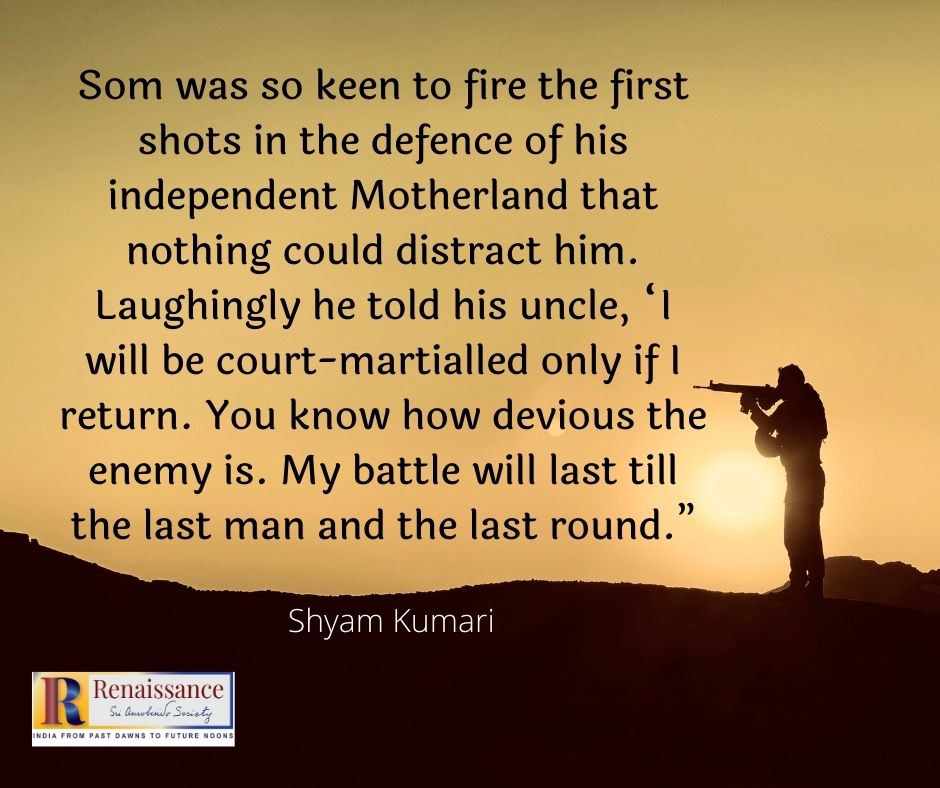
Somnath reached Srinagar on the morning of 31st October with about 70 men.
On the same day Brigadier L. P. Sen was appointed in place of Brigade Commander Katoch who was wounded. Brigadier Sen told Som that he could stay at the head- quarters and from there prepare a plan for the all-round defence of the airfield for up to four or five miles. But Som was not keen to send his men out for patrolling and action without himself accompanying them.
The Indian Army was taking all possible precautions to protect the airfield. But they had too few men for this. All the troops who had reached were by then busy facing thousands of tribesmen. The gravity of the situation was obvious. It was fortunate that the tribesmen had got busy looting on the way. Otherwise, they would have taken control of the airfield by then.
Tribesmen can not be relied upon when faced with an adverse situation; they run away from battle and start looting and plundering. That was why the British never enrolled them in the Army. Only once when the British had enrolled them in the Army, that unit had mutinied. The Pakistan Army had overlooked their unreliability and got the tribesmen to join them for the attack but this proved advantageous to India.
The enemy was trying guerrilla tactics to infiltrate into Srinagar.
Two companies of 4 Kumaon and one other company were ordered to hunt out and destroy the raiders. At eight on the morning of 3rd November with these two companies under his command, Major Somnath Sharma established a post three miles to the west of the airfield with 70 to 80 soldiers and took position on the high ground above Badgam village over the limit of the forest.
It was a burial ground and there were white and blue flowers in bloom there. From there one could see the bottom of a valley and beyond that on the slope of the mountain, could be seen the road to Gulmarg. Som reported to Brigadier Sen on the radio that all was quiet there and that the villagers were going about their normal work. One company came back to the airfield without any confrontation with the enemy.
Continued in PART 4

~ Design: Beloo Mehra
~ Manuscript preparation: Biswajita Mohapatra

